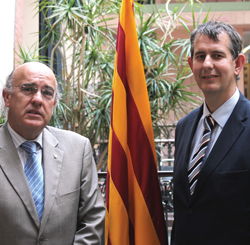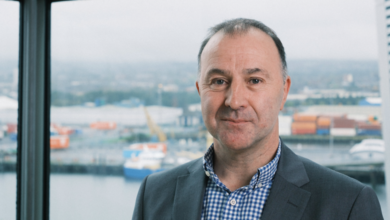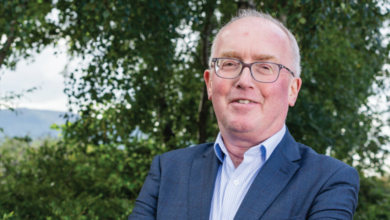Northern Ireland’s health technology exports
Peter Cheney sums up how new technology from Northern Ireland can help to develop the region’s manufacturing base and rekindle innovation.
Combined innovation in ICT and life sciences is emerging as a promising growth factor for Northern Ireland’s economy, with links to the USA, Finland and Spain helping to build up the province’s international profile.
Around 60 businesses, employing 4,100 people, make up the province’s life sciences sector. Annual sales total $600 million (£390 million), of which 95 per cent are exports.
Health Minister Edwin Poots has visited all three countries over the last year to promote the sector, and many of the relationships are being developed through the Northern Ireland and Massachusetts Connection (NIMAC), a business and academic collective.
Stops on Poots’ US visit in October included the Patient Safety and Technology Laboratory (also known as the Sims Lab) at Massachusetts General Hospital and the Partners Centre for Connected Health, both in Boston.
The Sims Lab brings “multi-disciplinary engineering skills to bear on real clinical problems” and is named after its founder and leader, Dr Nathaniel M Sims, an assistant professor of anaesthesia at Harvard Medical School. Developed under the common theme of “system technology that impacts patient safety”, specific patents have included:
• ‘smart pumps’ which confirm whether an administered dose is safe by checking the dosage against hospital guidelines;
• anaesthesia drug labelling where the reading of barcode on a vial is used to print a coloured label with all appropriate information for the syringe;
• a ‘patient care kiosk’ which facilitates two-way video and audio links and monitors blood pressure, heart rate, weight and blood coagulation times etc.; and
• a pager-style device that reminds clinicians to wash their hands if they have not already done so before entering a protection zone.
Intelesens has worked with the Sims Lab to develop Aingeal, a wireless vital signs monitoring solution. Worn on the body, it is attached to the torso using an adhesive electrode patch and monitors heart rate, temperature, motion and respiration rate (a first for walking patients). The device can be worn from admission at A&E until the patient’s discharge from hospital.
The Partners Centre is exploring
m-health: the use of mobile phone technology to improve the quality of care. This, for example, involves sending text messages to encourage people to apply sunscreen, give young single mothers advice about a healthy pregnancy, and remind drug addicts to attend tests and appointments.
During his visit, Poots met US Assistant Commerce Secretary Nicole Lamb-Hale to discuss the potential for co-operation and how this can benefit the USA and Northern Ireland. Lamb-Hale is responsible for US manufacturing policy and specialised in business restructuring in manufacturing during her previous legal career.
Focus on solutions
He told agendaNi that he was “very impressed” with the work of both organisations and the potential for closer collaboration with Northern Ireland institutions.
“It is not so much specific technologies which are of interest as the ways in which they can be utilised,” Poots remarked. “Our approach is to identify problems which need a solution and then look for the technology (or other approach) which can provide that solution. Sometimes the answer won’t currently exist and we will have to work with researchers and companies to develop new solutions. Other times, the answer will lie in innovative applications of readily available everyday technologies.”
He also pointed to the need for the right underlying infrastructure to facilitate new systems.
The electronic care record, for example, will be rolled out over the next year and could provide some therapies remotely by enhanced tele-monitoring and extending the use of telecare. The
£9 million contract for the service (with Orion Health over seven years) was announced in May.
An £18 million remote tele-monitoring project (Telemonitoring NI) was launched in December, to assist 20,000 patients with chronic diseases over five years.
In February, the Minister spoke at a NIMAC conference on connected health in Helsinki before visiting the Finnish state-owned research institute VTT (agendaNi issue 50, page 52).
“Northern Ireland can influence European policy. Our size is an asset in the testing of new innovations. It allows us to be a leader in the field by sharing our experiences,” he stated.
The message was reinforced in Barcelona in May, when he addressed the European Connected Health Alliance Leadership Summit. Our region, he explained, was small enough to be “nimble and flexible with an integrated health and social care system” but also large enough to provide “a solid, substantial research base for international and local businesses.”
Kainos had just signed an agreement with VTT to develop early diagnosis technology for Alzheimer’s disease, a project with the potential to “benefit the quality of life for thousands of people.”
The twin challenges of “constrained resources and rising demand” meant that the Health Service, academia and industry needed to work more closely together.
Poots also met Catalan Health Minister Boi Ruiz I Garcia (a former orthopaedic and trauma surgeon) and said that both countries could learn from their experiences of health technology. The Catalan Government, Minister Ruiz confirmed, is “very interested” in Northern Ireland’s health and social care model.
He also met Basque Health Minister Rafael Bengoa for a similar discussion in Bilbao, particularly on how to reduce unnecessary hospital admissions. Finland, Catalonia and Northern Ireland will work together to apply for funding through the European Innovation Partnerships, a hi-tech support programme.
American companies have visited Northern Ireland to explore investing in the local life science sector. The Minister and Andrew McCormick have also met potential US investors in London and NIMAC has held similar meetings.
“Whilst commercial sensitivity means that we cannot discuss individual companies,” Poots commented, “some of the ideas coming forward are innovative and exciting and hold great potential.”
Support project moves forward
Behind the scenes, a memorandum of understanding (between DHSSPS and Invest NI) to assist life science businesses was signed in December; a strategic action plan is now being drawn up. The sector, it notes, would benefit from lower corporation tax and could in turn boost the value of Northern Ireland’s manufacturing exports.
Four priorities are set out for the first year: targeted connected health R&D and innovation funding; developing the Northern Ireland ‘connected health eco-system’; collaboration with international regions for mutual gain; and promoting the connected health agenda internationally.
The project board is chaired by DHSSPS Permanent Secretary Andrew McCormick and Invest NI Chief Executive Alasdair Hamilton, and comprises representatives from DHSSPS, Invest NI, Queen’s University Belfast, the University of Ulster and the private sector.
Leadership of the eight-strong project team will rotate between the two organisations, with DHSSPS taking the lead up to December 2012.






